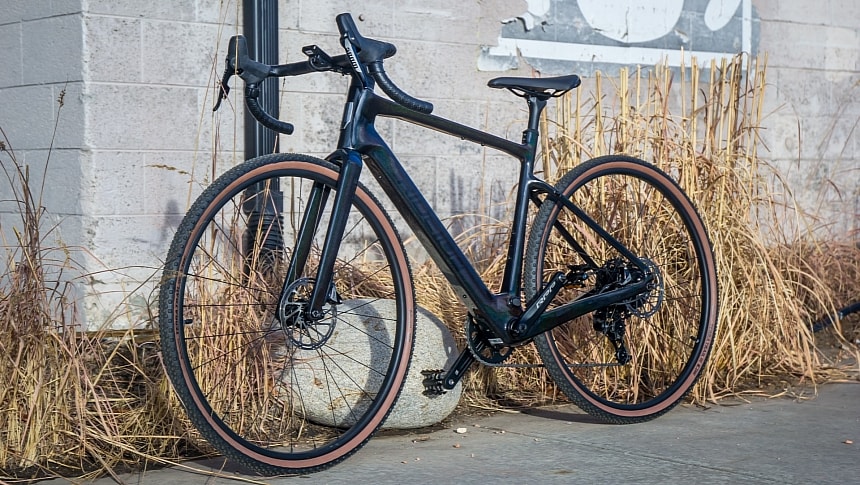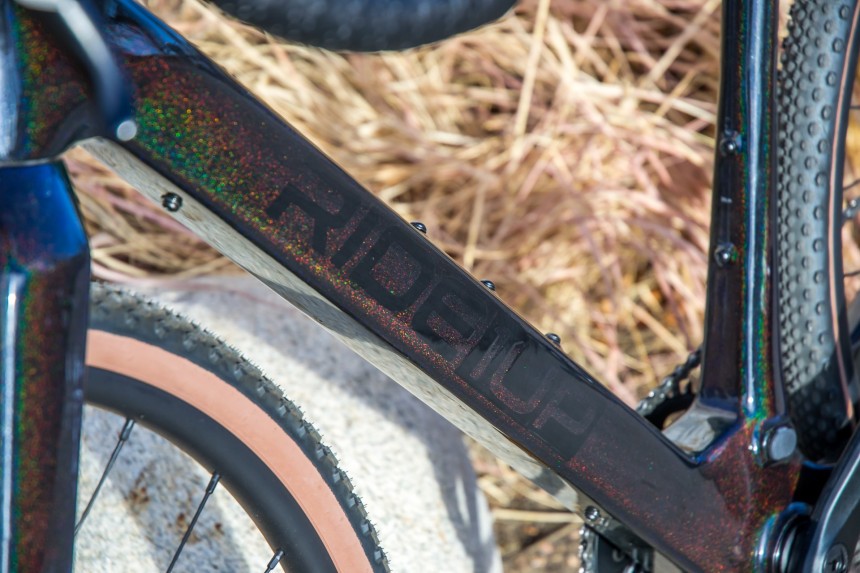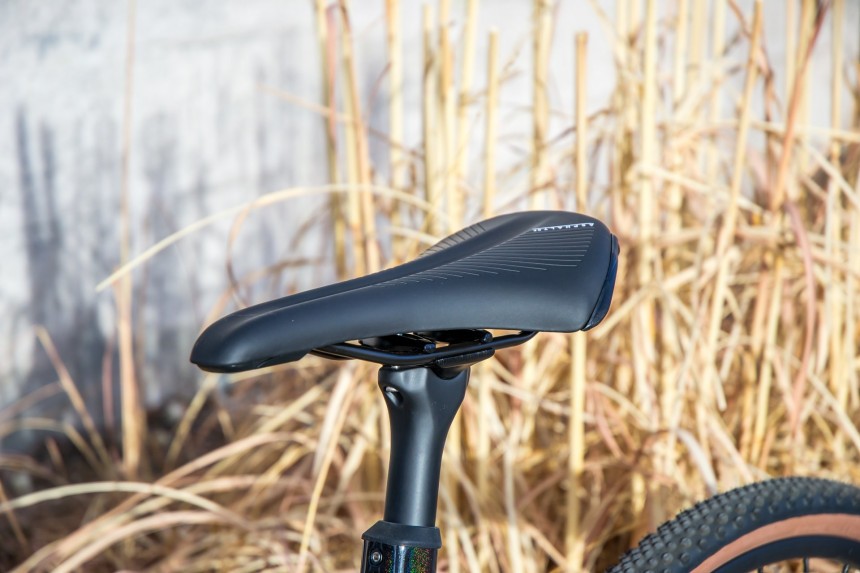Carbon fiber is an expensive, fickle material. It takes a lot of effort to produce, but the strength-to-weight ratio is something that’s hard to ignore- especially in the cycling world. E-bikes are, typically, pretty heavy, and the material is an obvious solution to an obvious problem, doubly so when it comes to racing bikes.
The Ride1UP CF Racer1 weighs 27.4 pounds at its heaviest thanks to its carbon fiber frame. This is a portly bike only in the world of carbon-framed gravel/road racers, but not so when you consider the 250-watt geared rear-hub motor with 42 nm of torque and 36-volt integrated Samsung battery. The combination, shifted via a Rival 1 11-speed double-tap transmission, will propel the Racer to a top speed of 28 mph- more than enough for some real speed on gravel trails.
Unbox Ride1Up’s latest (and assemble it), and there’s real attention to detail that’s immediately noticeable. Not only did the kit ship with an entire torque wrench, and a pretty nice one at that, but the torque specs for just about every bolt on the bike are written next to its housing. With that, maintenance should be a breeze. There are even torque specs written next to the water bottle cage mounts, of which there are three: one on the interior bottom frame, one opposite closest to the ground, and one on the saddle-side. There are some places where the brand clearly has to cut costs in order to fit such a low price point, however.
For starters, there’s the pedals. The RPP arms are nice, but there are lighter units out there. Second, there are no clipless pedals. Thankfully, anyone with a wrench and a few spare minutes can remedy this. Ride1Up puts all its bike specs up on its website, and finding clipless pedals to fit should be a breeze. This is a performance-oriented bike, and while the flat pedals make riding more accessible for a greater range of buyers, we also think there should be at least the option. Finally, it's worth mentioning the bike’s bars. The fake PU leather on them can be swapped and should be. Especially for gravel riding, we found ourselves wanting some more padding. It might add a few precious grams, but like the bike’s electric driveline, the added weight means more time in the saddle.
Speaking of the saddle, this one is made by Selle, specifically the Royale Asphalt GF. It does the job, but it’s by no means a comfort item. Again, owners should be able to easily swap this should they desire more pad or more coccyx relief. That said, the saddle does feature standard adjustability and worked well on our longest test ride.
None of these bits are tied to the electric driveline in any meaningful way, and like many of the brand’s other e-bikes, this one is a pleasure to use. That said, the CF Racer1 uses cadence instead of torque sensing, which some might find a little disruptive. Indeed, there is a bit of a delay, but on such a light bike, it also isn’t a very noticeable one. Additionally, the 42nm of torque feels like a kick in the pants on such a light bike, and the various levels of electric assist can be adjusted via toggles on the drop bars. Do be careful with these, however, as the plastic bands securing ours to the bike fell off, never to be seen again. It may be worth wrapping more bar tape around these for more secure fitment.
The brakes work stunningly well, and more importantly, are easy to modulate. You can even do so while shifting, thanks to the shifter’s double-tap design. Despite a hardly noticeable pause on initial input, torque comes on smooth, and it's easy to accelerate even on loose surfaces. This is a fixed-fork design, and the ride can’t be called comfortable by any stretch. Racing cars aren’t comfortable, and neither are racing bikes.
Pros
Cons
Design Evaluation
It’s worth noting that while this bike is the “gravel” spec, with its Continental Terra tires, different rims, cassette, and slightly thicker bars, Ride1Up will also sell you a road spec bike, which comes in just slightly lighter thanks to a different combination of the same. The difference is right around 1 pound, and we figured at the very least, the gravel bike’s thicker bars might make for some more comfortable riding, and that the extra pound would be accounted for by a post-ride burrito one way or the other. All told, the test unit seen here came in at $2,295. The pricing sticks to Ride1Up’s affordable, e-bikes-for-all ethos, and serves much the same purpose as other performance e-bikes: we see it more as a range extender than a performance enhancer, and it’s easy to cover car-like mileage in a single ride at almost any fitness level. Combine this with the aggressive pricing, and the Racer looks like a real entry point to performance e-bikes.Unbox Ride1Up’s latest (and assemble it), and there’s real attention to detail that’s immediately noticeable. Not only did the kit ship with an entire torque wrench, and a pretty nice one at that, but the torque specs for just about every bolt on the bike are written next to its housing. With that, maintenance should be a breeze. There are even torque specs written next to the water bottle cage mounts, of which there are three: one on the interior bottom frame, one opposite closest to the ground, and one on the saddle-side. There are some places where the brand clearly has to cut costs in order to fit such a low price point, however.
For starters, there’s the pedals. The RPP arms are nice, but there are lighter units out there. Second, there are no clipless pedals. Thankfully, anyone with a wrench and a few spare minutes can remedy this. Ride1Up puts all its bike specs up on its website, and finding clipless pedals to fit should be a breeze. This is a performance-oriented bike, and while the flat pedals make riding more accessible for a greater range of buyers, we also think there should be at least the option. Finally, it's worth mentioning the bike’s bars. The fake PU leather on them can be swapped and should be. Especially for gravel riding, we found ourselves wanting some more padding. It might add a few precious grams, but like the bike’s electric driveline, the added weight means more time in the saddle.
None of these bits are tied to the electric driveline in any meaningful way, and like many of the brand’s other e-bikes, this one is a pleasure to use. That said, the CF Racer1 uses cadence instead of torque sensing, which some might find a little disruptive. Indeed, there is a bit of a delay, but on such a light bike, it also isn’t a very noticeable one. Additionally, the 42nm of torque feels like a kick in the pants on such a light bike, and the various levels of electric assist can be adjusted via toggles on the drop bars. Do be careful with these, however, as the plastic bands securing ours to the bike fell off, never to be seen again. It may be worth wrapping more bar tape around these for more secure fitment.
Real World Application
Swing a leg over the bike, and the CF immediately feels serious. The riding position is swept low, and you already feel like you’re playing Wout van Aert. Fixed in the middle of the low, wide bars is a color display that reads the bike’s odometer, power assist level, wattage, speed, and time. Essentially, it’s all the information you’d ever need. Ride1Up claims range for the bike is between 10 and 40 miles, but as with any e-bike, that depends highly on the rider’s build and the level of assist. There’s a real separation between each of these assist levels, and the fifth (and highest) feels like riding on easy mode. The bike is also light enough to be ridden without assistance for more of a workout.The brakes work stunningly well, and more importantly, are easy to modulate. You can even do so while shifting, thanks to the shifter’s double-tap design. Despite a hardly noticeable pause on initial input, torque comes on smooth, and it's easy to accelerate even on loose surfaces. This is a fixed-fork design, and the ride can’t be called comfortable by any stretch. Racing cars aren’t comfortable, and neither are racing bikes.
Conclusion
What the CF does give up in comfort, you’ll get back in speed, and effortless speed at that. The bike handles on rails, even with its skinny, sometimes skittish tire setup. The bars are narrow in width, providing a very direct feeling when steering, and the riding position makes pedaling and staying tucked relatively easy. Combine a solid riding experience with decent pricing for such exotic materials and we think Ride1Up has got another winner on its hands.Pros
- Supremely light gravel e-bike
- Carbon fiber frame
- Grabby disk brakes
- Rapid double-tap shifter
Cons
- Gravel bike bars need more padding
- Cadence-sensing motor may not be for everyone
- No clipless pedals



























